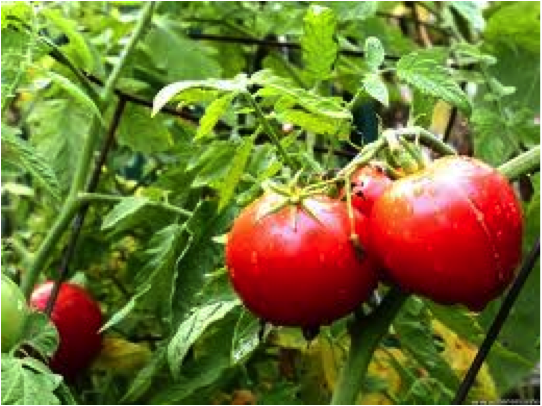Tomatoes! Nothing says summer more than the aroma and taste of a freshly picked “vine” ripened tomato. Ah. The tomato is why we garden, even in places like Alaska! And, the more tomatoes we grow, the more we have to share!
So celebrate Earth Day this year by joining forces with WM EarthCare™ and the U.S. Composting Council in the Million Tomato Compost Campaign. Officially launching on April 21, the goal of the campaign is to have a million tomatoes planted in school and community gardens across the nation with the “fruits” of each garden being donated to local food banks. To spice up the campaign, local chefs will share their tomato recipes and participate in local tasting events. It’s all about showing how compost can build healthy soil and provide sustainably grown local food for our communities. It’s nature’s way to grow!
WM EarthCare™ is spreading the word, compost and tomato seeds to local community gardens to help reach the million tomato mark. Participating organizations (as of April 15) include:
• Acta Non Verba: Youth Urban Farm Project cultivates a quarter acre farm in East Oakland that is planned, planted, harvested and sold by youth grades K – 8th and 100% of the proceeds placed into individual savings accounts for those who have participated, thereby building the community from the ground up.
• City Slicker Farms has been partnering with the West Oakland community since 2001 to grow and distribute thousands of pounds of its own fresh produce to achieve equal access to fresh, healthy organic food.
• Dig Deep Farms & Produce is a social enterprise project of the Alameda County Deputy Sheriffs’ Association that grows fresh, healthy, affordable vegetables on its farm spaces in Ashland, Cherryland, San Leandro and Castro Valley.
Throughout the summer long event, WM EarthCare will record the total weight of tomatoes grown and donated. Local results will be recorded on the U.S. Composting Council’s national website.
In the spirit of healthy competition, local nurseries and landscapers may also participate by sponsoring a Million Tomato Compost garden with a donation of tomato seeds, tomato plants, or garden supplies. You provide the seed and we’ll provide the compost.
Registration is easy. Visit the Community Giving section of the WM EarthCare™ website and complete the online compost donation form. Be sure to indicate that you are participating in the Million Tomato Campaign in the box that asks you to describe your organization. And, don’t forget to sign up for our monthly newsletter, The Scoop, to keep track of special Million Tomato events and your garden’s harvest progress. See, that was easy!
Now, for those of you who need a crash course on how to grow tomatoes, I welcome you to WM EarthCare™ Tomatoes 101.
The tomato is probably the most widely grown plant in the United States. It’s generally considered easy to grow, and gives you a great return on your investment (i.e., lots of marinara sauce). Even so, there are a few basics that will make your tomato growing experience more enjoyable.
 Let’s start with some tomato terminology. Seed packets and 6-packs alike label tomato plants as determinate or indeterminate. The distinction rests largely in whether you want your tomatoes to ripen all at once (determinate), or whether you’d like to spread your harvest out (indeterminate). Aside from when to expect the arrival of fruit (yes, the tomato is a fruit), determinate tomato varieties tend to be shrub-like, while indeterminate varieties tend to be more leggy. I have experienced equal success growing both determinate and indeterminate varieties.
Let’s start with some tomato terminology. Seed packets and 6-packs alike label tomato plants as determinate or indeterminate. The distinction rests largely in whether you want your tomatoes to ripen all at once (determinate), or whether you’d like to spread your harvest out (indeterminate). Aside from when to expect the arrival of fruit (yes, the tomato is a fruit), determinate tomato varieties tend to be shrub-like, while indeterminate varieties tend to be more leggy. I have experienced equal success growing both determinate and indeterminate varieties.
Whether you grow tomatoes in a container or directly in the ground, two things are critical: sunlight and good drainage. Locate your tomatoes where they’ll get at least 10 hours of sunlight each day. In places where the afternoon sun and heat dominate, you may need to introduce a little shade.
 If growing in a container or raised bed use a planting mix that’s 50% high quality USCC-STA compost, 20% aged bulk manure, 10% horticultural sand, 10% perlite, and 10% vermiculite, and be sure that the container is roughly the size of a 5 gallon plastic bucket. Recycled plastic buckets work well, just be sure to drill a dozen or so 1/4” holes in the bottom for drainage.
If growing in a container or raised bed use a planting mix that’s 50% high quality USCC-STA compost, 20% aged bulk manure, 10% horticultural sand, 10% perlite, and 10% vermiculite, and be sure that the container is roughly the size of a 5 gallon plastic bucket. Recycled plastic buckets work well, just be sure to drill a dozen or so 1/4” holes in the bottom for drainage.
To plant tomatoes directly in the ground, prepare the site by mixing 4” of high quality compost with 2” of aged manure into the top 8” of soil. Space plants approximately 2’ apart, making sure to stake and tie the plants well as they grow.
At planting, don’t be afraid to bury the stem of your tomatoes right up to the first set of leaves. Tomatoes naturally develop roots from the stem, so plant them deep. The stronger the roots, the better the tomatoes. To conserve moisture and prevent weeds, add 2” of mulch around your tomatoes taking care not to mound mulch around the plant stems.
Some gardeners believe that tomatoes must be trimmed and suckers removed to promote the best production. Frankly, I think this is nonsense and actually counterproductive, not to mention time consuming. The foliage of the plant protects the fruit from sunscald. Leave it! What’s more important is to be sure that as your tomatoes grow, the sprawling plant is kept from having too much contact with the ground. Plants that rest on the ground frequently develop pest problems in the form of fungus, insect, or both. Keep your plants tied and well trained to ensure sufficient air circulation.
Water your tomatoes using a soaker hose (my choice), drip emitter, or watering can directed at the soil, not the foliage. Keep the foliage as dry as possible. Tomatoes are deep rooted and like regular water at root level. This calls for less frequent longer periods of (deep) watering, rather than frequent short bursts of water. When it comes to tomatoes and fertilizer, I say, don’t use it. Look, you’re growing your tomatoes with high quality compost. The compost should have everything your plants need. It’s especially important not to fertilize your tomatoes after the first blossoms appear. How many dark green Jack and Bean Stalk-sized tomato plants have you seen with no tomatoes to be found? Too much fertilizer does not a tomato make. Stick to compost, and leave well enough alone. Erase that “fertilize every two weeks nonsense” from your mind.
That completes Tomatoes 101. Now register to participate in the Million Tomato Compost Campaign, and start growing!
Look for growing tips, recipes and more in future editions of The Scoop.
Happy Earth Day!
Dig in!
~The Dirt Dude



